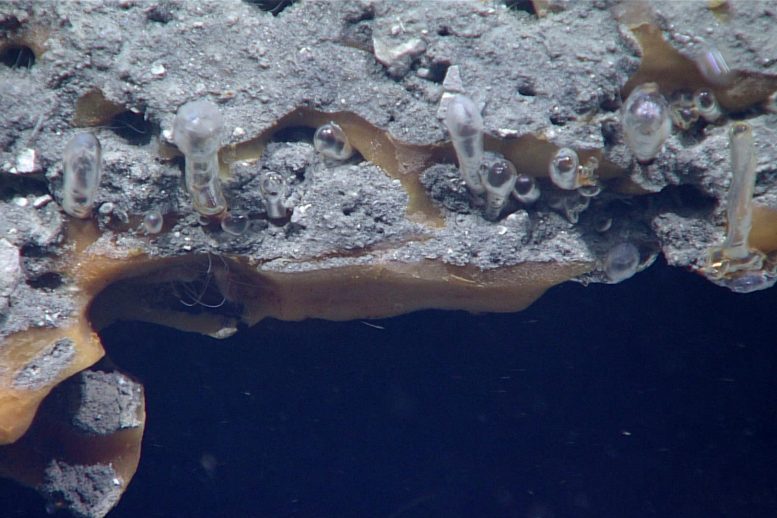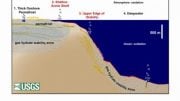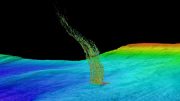
A new study helps explain how and why columns of methane gas can stream out of seafloor formations known as methane hydrates. Credit: Image courtesy of the NOAA Office of Ocean Exploration and Research, Gulf of Mexico 2017.
Leakage from frozen layers was a puzzle, but a new study shows how the potent greenhouse gas breaks through icy barriers.
Methane, the main component of natural gas, is the cleanest-burning of all the fossil fuels, but when emitted into the atmosphere it is a much more potent greenhouse gas than carbon dioxide. By some estimates, seafloor methane contained in frozen formations along the continental margins may equal or exceed the total amount of coal, oil, and gas in all other reservoirs worldwide. Yet, the way methane escapes from these deep formations is poorly understood.
In particular, scientists have been faced with a puzzle. Observations at sites around the world have shown vigorous columns of methane gas bubbling up from these formations in some places, yet the high pressure and low temperature of these deep-sea environments should create a solid frozen layer that would be expected to act as a kind of capstone, preventing gas from escaping. So how does the gas get out?
A new study helps explain how and why columns of the gas can stream out of these formations, known as methane hydrates. Using a combination of deep-sea observations, laboratory experiments, and computer modeling, researchers have found phenomena that explain and predict the way the gas breaks free from the icy grip of a frozen mix of water and methane. The findings are reported today in the journal PNAS, in a paper by Xiaojing (Ruby) Fu SM ’15, PhD ’17, now at the University of California at Berkeley; Professor Ruben Juanes at MIT; and five others in Switzerland, Spain, New Mexico, and California.
Surprisingly, not only does the frozen hydrate formation fail to prevent methane gas from escaping into the ocean column, but in some cases it actually facilitates that escape.
Early on, Fu saw photos and videos showing plumes of methane, taken from a NOAA research ship in the Gulf of Mexico, revealing the process of bubble formation right at the seafloor. It was clear that the bubbles themselves often formed with a frozen crust around them, and would float upward with their icy shells like tiny helium balloons.
Later, Fu used sonar to detect similar bubble plumes from a research ship off the coast of Virginia. “This cruise alone detected thousands of these plumes,” says Fu, who led the research project while a graduate student and postdoc at MIT. “We could follow these methane bubbles encrusted by hydrate shells into the water column,” she says. “That’s when we first knew that hydrate forming on these gas interfaces can be a very common occurrence.”
But exactly what was going on beneath the seafloor to trigger the release of these bubbles remained unknown. Through a series of lab experiments and simulations, the mechanisms at work gradually became apparent.
Seismic studies of the subsurface of the seafloor in these vent regions show a series of relatively narrow conduits, or chimneys, through which the gas escapes. But the presence of chunks of gas hydrate from these same formations made it clear that the solid hydrate and the gaseous methane could co-exist, Fu explains. To simulate the conditions in the lab, the researchers used a small two-dimensional setup, sandwiching a gas bubble in a layer of water between two plates of glass under high pressure.
As a gas tries to rise through the seafloor, Fu says, if it’s forming a hydrate layer when it hits the cold seawater, that should block its progress: “It’s running into a wall. So how would that wall not be preventing it from continuous migration?” Using the microfluidic experiments, they found a previously unknown phenomenon at work, which they dubbed crustal fingering.
If the gas bubble starts to expand, “what we saw is that the expansion of the gas was able to create enough pressure to essentially rupture the hydrate shell. And it’s almost like it’s hatching out of its own shell,” Fu says. But instead of each rupture freezing back over with the reforming hydrate, the hydrate formation takes place along the sides of the rising bubble, creating a kind of tube around the bubble as it moves upward. “It’s almost like the gas bubble is able to chisel out its own path, and that path is walled by the hydrate solid,” she says. This phenomenon they observed at small scale in the lab, their analysis suggests, is also what would also happen at much larger scale in the seafloor.
That observation, she said, “was really the first time we’ve been aware of a phenomenon like this that could explain how hydrate formation will not inhibit gas flow, but rather in this case, it would facilitate it,” by providing a conduit and directing the flow. Without that focusing, the flow of gas would be much more diffuse and spread out.
As the crust of hydrate forms, it slows down the formation of more hydrate because it forms a barrier between the gas and the seawater. The methane below the barrier can therefore persist in its unfrozen, gaseous form for a long time. The combination of these two phenomena — the focusing effect of the hydrate-walled channels and the segregation of the methane gas from the water by a hydrate layer — “goes a long way toward explaining why you can have some of this vigorous venting, thanks to the hydrate formation, rather than being prevented by it,” says Juanes.
A better understanding of the process could help in predicting where and when such methane seeps will be found, and how changes in environmental conditions could affect the distribution and output of these seeps. While there have been suggestions that a warming climate could increase the rate of such venting, Fu says there is little evidence of that so far. She notes that temperatures at the depths where these formations occur — 600 meters (1,900 feet) deep or more — are expected to experience a smaller temperature increase than would be needed to trigger a widespread release of the frozen gas.
Some researchers have suggested that these vast undersea methane formations might someday be harnessed for energy production. Though there would be great technical hurdles to such use, Juanes says, these findings might help in assessing the possibilities.
“The problem of how gas can move through the hydrate stability zone, where we would expect the gas to be immobilized by being converted to hydrate, and instead escape at the seafloor, is still not fully understood,” says Hugh Daigle, an associate professor of petroleum and geosystems engineering at the University of Texas at Austin, who was not associated with this research. “This work presents a probable new mechanism that could plausibly allow this process to occur, and nicely integrates previous laboratory observations with modeling at a larger scale.”
“In a practical sense, the work here takes a phenomenon at a small scale and allows us to use it in a model that only considers larger scales, and will be very useful for implementing in future work,” Daigle says.
The research team included Joaquin Jimenez-Martinez at the Swiss Federal Institute of Aquatic Science and Technology; Than Phon Nguyen, William Carey and Hari Vinaswanathan at Los Alamos National Laboratory; and Luis Cueto-Felgueroso at the Technical University of Madrid. The work was supported by the U.S. Department of Energy.









“Methane, …, is the cleanest-burning of all the fossil fuels, but when emitted into the atmosphere it is a much more potent greenhouse gas than carbon dioxide.”
I think that the editor is remiss in not also mentioning that, when released to the atmosphere, it is rapidly oxidized to form CO2, and has a much shorter half-life than CO2. Also, it is much less abundant than CO2. I think that it is important to keep things in perspective.
https://en.wikipedia.org/wiki/Atmospheric_methane
Very Very Interesting.
Some views for consideration.
1. All materials exist in solid, liquid, or gaseous forms and a combination of the same and sometimes a viscous mix of the same. Temperature, Pressure and the properties of these materials can determine in what form it exists currently and also in what form it will exist if the conditions change in the future at the quantum level, at the Nano level , micro level and Gross level.
2. Earth Sciences and most processes which occur deepe within the earth are barely understood. For e,g. what drives the movement of the tectonic plates floating independently with huge different masses, in terms or speed and acceleration?Momemntum involved is huge. Are they just floating like objects on a Ocean of molten lava or are they driven by other forces? If they are floating on a Ocean of molten lava, a rcent algorithm which helps to locate the same lost in the oceans quickly will help. Maybe this has a role to play in the movement of these tectonic plates and can be accurately calculated/ estimated ? If there are other forces driving the same then what are these forces and what role do nearby heavenly bodies play in such movement, if any ? If the waves and oceans are impacted by the moon and low tide and high tides, it is quite likely even distant objects and heavenly bodies do impact suchbevents. As we are 70$ water , it probably impacts us as well, tough todays scientists dismiss astrology as a pseuod sign, I bet you that the first thing that all ladies and gentlemen check out in the daily newspaper is the “Star Forecast: Column of his/her star sign!! Ha! Ha! All ecosystems are complex , including humans.
3. If Oceanic plates and continental plates run into each other or scapare against each other we assume that the impact on the continental crust may be solely due to such impact and ignore the possibility of the impact of the materials of the continental crusts in various forms and the build up of stress and strain , which result in such build-up of forces which could lead to catostrophic events like volacnoes and earthquakes etc.
4.Coming to the phenomenon being desrcribed above, may the same has a role to play in strees/ straing /pressure build-up on the earths crust and ameleorate the same by gases like methane escaping from the bowels of the earth over short medium and longer time frames.
5. After all Carbon, Nitrogen and Oxygen AND HYDROHEN do seem to play a prominent role in the planet along with a combination of Hydrogen and oxygen (Water) as well as oyxgen and carbon-di-oxide in the process of life. Similarly Nitrogen too appears to play a prominent role ( Nitrogenous fertilizers). As does Phosphorous ( Phosphatic Fertilizers). As do trace elements .
6.However to assume that life can emerge purely on the basis of such elements put on a petri dish as a stretch at best with current understanding of Science. However , best of luck to the scientists attempting to brethe life into a a complex combination of chemicals.
6. Methane is a fossil fuel. It is probably the cheapest among the fossil fuels. However , there are far cheaper ones which shines on us on most sunny days and is only eight minutes away.Probably Hydrogen is the most abundant material in the know universe ( as 85% of the universe is unknown and no one nows what dark matter consists of , and hydrogen too can provide limitless energy to meet the needs of humanity. Mastering these twotechnologies will certainly change the economics of the energy.
7We should be ensuring the strategic dissonance which is going to constantly change industries and nations, and I suspect is unstoppable, and put in place policies and processes protects the people who are affected and protected against disruption ae best as possible and social disruption is minimised. The world does not Water Wars, Eneegy Wars, Food wars, but solutions from the Scintists and technologists . Best of luck to the world. Hope always springs eternal for a better and more prosperous future for all. Science and basic and applied Scientific progress is the best hope for humanity.
I repeat —-Views expressed are personal and not binding on others.